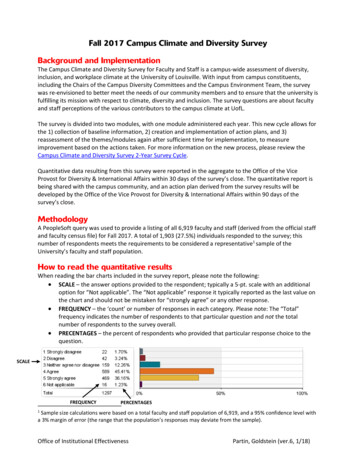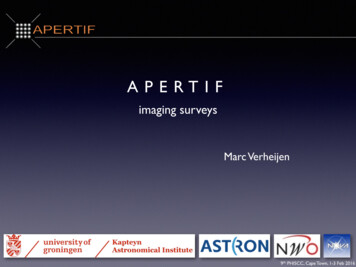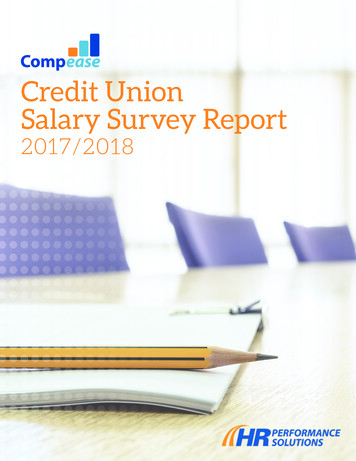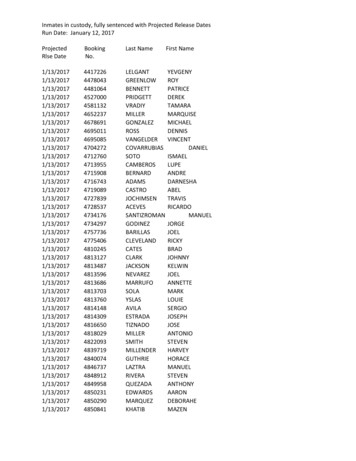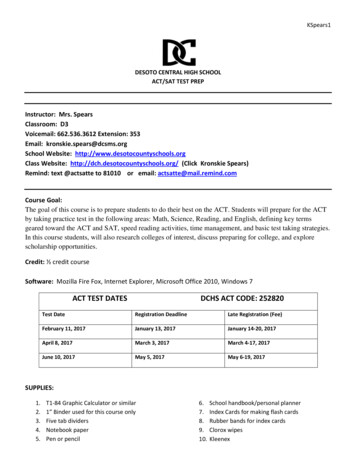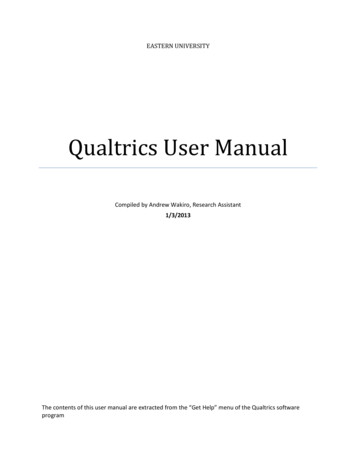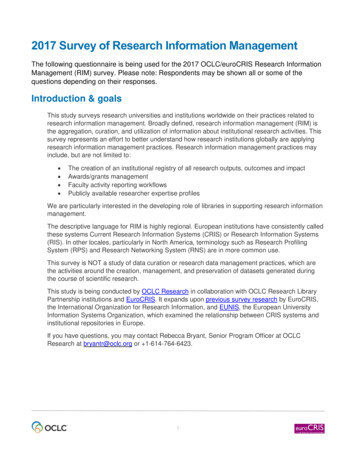
Transcription
2017 Survey of Research Information ManagementThe following questionnaire is being used for the 2017 OCLC/euroCRIS Research InformationManagement (RIM) survey. Please note: Respondents may be shown all or some of thequestions depending on their responses.Introduction & goalsThis study surveys research universities and institutions worldwide on their practices related toresearch information management. Broadly defined, research information management (RIM) isthe aggregation, curation, and utilization of information about institutional research activities. Thissurvey represents an effort to better understand how research institutions globally are applyingresearch information management practices. Research information management practices mayinclude, but are not limited to: The creation of an institutional registry of all research outputs, outcomes and impactAwards/grants managementFaculty activity reporting workflowsPublicly available researcher expertise profilesWe are particularly interested in the developing role of libraries in supporting research informationmanagement.The descriptive language for RIM is highly regional. European institutions have consistently calledthese systems Current Research Information Systems (CRIS) or Research Information Systems(RIS). In other locales, particularly in North America, terminology such as Research ProfilingSystem (RPS) and Research Networking System (RNS) are in more common use.This survey is NOT a study of data curation or research data management practices, which arethe activities around the creation, management, and preservation of datasets generated duringthe course of scientific research.This study is being conducted by OCLC Research in collaboration with OCLC Research LibraryPartnership institutions and EuroCRIS. It expands upon previous survey research by EuroCRIS,the International Organization for Research Information, and EUNIS, the European UniversityInformation Systems Organization, which examined the relationship between CRIS systems andinstitutional repositories in Europe.If you have questions, you may contact Rebecca Bryant, Senior Program Officer at OCLCResearch at bryantr@oclc.org or 1-614-764-6423.1
Who should participate? We invite participation from universities, research institutes, and other organizationssupporting research and research management.We encourage your institution to participate in this survey regardless of the status of yourRIM implementation--whether you are currently exploring, implementing, or in production.Please complete no more than one survey per institution.We recognize that research information management practices take place across institutionalunits, and that consultation with others in your institution may be required to accurately completeall questions. We thank you in advance for taking the time to complete this questionnaire, whichwill provide important information to the community about evolving research informationmanagement practices. We anticipate that the survey should take 20-40 minutes to complete,depending upon the status of your local RIM implementation (institutions with live RIM systemswill complete more questions than those in the planning stages). Questions marked with anasterisk (*) are required. A PDF copy of the survey is available for your advance review.Survey results will be openly availableSurvey results will be published in 2018 as an OCLC Research report and made openly availableto the community. While the survey requests name and contact information of the individualcompleting the survey, your institution may be identified but no personal information will beshared. Survey data (minus individual contact information) will be published CC-BY.I have read the above information and affirm that I am 18 years of age or older. By clicking“CONTINUE”, I consent to participate in the research study of research information managementpractices.Survey development team:Rebecca Bryant, OCLC ResearchPablo de Castro, University of Strathclyde & euroCRISAnna Clements, -report/& euroCRISJan Fransen, University of Minnesota, Twin CitiesJulie Griffin, Virginia TechConstance Malpas, OCLC ResearchMichele Mennielli, DuraSpace & euroCRISRachael Samberg, University of California-Berkeley2
Please choose the status that best describes your institution’s research informationmanagement (RIM) implementation stage.* (*Note: This question is required.)a. Live Implementation: Currently live with RIM system and service made publicly visible to campusstakeholdersb. In the process of implementing: A decision has been made on which RIM system(s) to use; contractsare signed but not yet operational.c. Procurement Process: In the procurement process - in the process of evaluating specific systemsunder considerationd. Exploring: Defining system requirements and comparing available optionse. Not considering: Not considering a RIM system at this time1. Please indicate the importance of the following reasons for pursuing research informationmanagement (RIM) activities.*[Using a scale of Extremely Important – Important – Somewhat Important – Not Important – N/A or Not Sure] Managing annual academic activity reportingSupporting expertise discoverySupporting institutional compliance (e.g., funder mandates, national assessment exercise like REF orERA, etc.)Supporting institutional reputation and strategic decision makingImproving services for researchersRecording institutional research facilities and their use2. What other reasons, if any, are most important to pursuing research informationmanagement activities?3. How important are the following functions of RIM at your institution?*[Using a scale of Extremely Important – Important – Somewhat Important – Not Important – N/A or Not Sure] Registry of institutional research outputsPublicly available researcher profilesReporting scholarly impactReporting societal impactExternal (e.g., National) research assessmentInternal reportingAnnual academic activity reporting workflowsAwards/grants management workflowsCompliance and open access to publicationsReuse (in CVs, biosketches, other web pages)Identifying collaborators or expertise3
4. What other functions, if any, are most important at your institution?5. Thinking about the following functions of RIM, how well do you feel your institution isperforming?*[Using a scale of Very Successfully – Successfully – Somewhat Successfully – Unsuccessfully – Haven’tStarted Yet - N/A (Won’t be doing this)] Registry of institutional research outputsPublicly available researcher profilesReporting scholarly impactReporting societal impactExternal (e.g., National) research assessmentInternal reportingAnnual academic activity reporting workflowsAwards/grants management workflowsCompliance and open access to publicationsReuse (in CVs, biosketches, other web pages)Identifying collaborators or expertise6. When did you begin implementing your current RIM system (following contract signing, ifapplicable)?*Year (YYYY)7. When did you launch your current RIM system, i.e., when was the service made publiclyvisible to campus stakeholders?*Year (YYYY)8. What RIM system(s) does your institution currently use?* (Select all that apply.) Developed in-houseConveris (Clarivate Analytics)DSpace-CRIS (Open source)Elements (Symplectic)Profiles (Open source)Pure (Elsevier)VIVO (Open source)Other (Please specify):4
9. Overall, how satisfied are you with:VerySatisfied765Neutral432Not at AllSatisfied1Developed in-houseConveris (Clarivate Analytics)DSpace-CRIS (Open source)Elements (Symplectic)Profiles (Open source)Pure (Elsevier)VIVO (Open source)Other (Please specify):10. Why are you satisfied or not?11. Is your RIM system(s) hosted externally or on campus?*HostedExternallyHosted onCampusDon’t KnowDeveloped in-houseConveris (Clarivate Analytics)DSpace-CRIS (Open source)Elements (Symplectic)Profiles (Open source)Pure (Elsevier)VIVO (Open source)Other (Please specify):12. Did you migrate from a previous RIM system(s)?* Yes No13. Which RIM system(s) did you previously use? (Select all that apply.) Developed in-houseConveris (Clarivate Analytics)DSpace-CRIS (Open source)Elements (Symplectic)Profiles (Open source)Pure (Elsevier)VIVO (Open source)Other (Please specify):14. You indicated your institution migrated from another RIM system. What prompted themigration?5
15. Do you anticipate your institution will migrate from your current RIM system in theforeseeable future?* Yes, within a yearYes, within the next 2-5 yearsNo, not in the foreseeable futureNot sure16. Which RIM system(s) will your institution migrate to? (Select all that apply.) Developed in-houseConveris (Clarivate Analytics)DSpace-CRIS (Open source)Elements (Symplectic)Profiles (Open source)Pure (Elsevier)VIVO (Open source)Other (Please specify):17. You indicated you anticipate your institution will migrate from your current RIM system(s).Why are you considering migrating to a new system?18. Which of the following internal systems interoperate with your RIM system(s)? (Select allthat apply.) Institutional authentication systemInstitutional repository (e.g., via a connector between DSpace and Pure)Research data repositoryElectronic Thesis/Dissertation (ETD) repositoryStudent information systemHuman resources systemUniversity finance and accounting systemProject management systemGrants management systemActive data management system (e.g., electronic lab notebook systems)Tech/knowledge transfer (e.g., patents)Enterprise business intelligence or analytics system (e.g., IBM Cognos, Tableau, SAPBusinessObjects)Library management systemOther (Please specify):None of the above19. Does your RIM system(s) serve as your default.*YesInstitutional repositoryResearch data repositoryElectronic Thesis/Dissertation (ETD) repository6NoDon’tKnowN/A (Don’tHave)
20. Which of the following external systems interoperate with your RIM system(s)? (Select allthat apply.) Government and/or private grants award systemNational or regional reporting system (e.g., educational/R&D statistics)Researcher/author ID registry/database (e.g., ISNI, ORCID, ResearcherID, Scopus ID)Organization ID registry/database (e.g., ISNI, GRID)Publication metadata sources (e.g., Web of Science, Scopus, ArXiv)Aggregated research portals (e.g., NARCIS, OpenAire, SHARE)Aggregated research data portals (e.g., RDDS, ANDS)Research metrics sources (e.g., Altmetric, ImpactStory, Plum Analytics)Other (Please specify):None of the above21. Which of the following publication metadata sources populate your RIM system(s)?* (Selectall that apply.) PubMedScopusWeb of ScienceEurope PubMed CentralGoogle BooksCrossrefWorldCatarXivSSRNMLA International BibliographydbplSAO/NASA Astrophysics Data SystemRePEcCiNiiSciELOOther (Please specify):None of the above22. Which of the following researcher identifiers are currently used in your RIM system(s)?(Select all that apply.) National authority file (LC/NACO, DAI, etc.)ISNIORCIDPubMed IDarXiv IDResearcherIDScopus IDVIAFOther (Please specify):None of the above7
23. Which of the following organization identifiers are currently used in your RIM system(s)?(Select all that apply.) National authority file (LC/NACO, DAI, etc.)GRIDISNIRinggoldCrossref Funder RegistryOther (Please specify):None of the above24. Which of the following protocols, standards or vocabularies does your RIM system(s) rely onor implement? (Select all that apply.) CASRAIField of Science (FOS) ClassificationOAI-PMHCERIF/CERIF XMLShibbolethOther (Please specify):None of the above25. Please select the stakeholder who has a primary responsibility for each activity as it relatesto the RIM system(s) at your institution.*UniversityAcademicLeadership(e.g., Provost,Chancellor)ResearchOffice AcademicHumanUnits (orResources equivalent)Proposing, initiating or drivingadoptionFinancial support for RIMSystem configurationMetadata entryMaintaining or servicing technicaloperationTraining and supportMetadata validation workflowsCreating internal reports for unitsProject managementStrategic development,management and planningOpen access, copyright anddepositResearch data managementImpact assessment and reportingOutreach and communicationsWhat other stakeholders, if any, have primary responsibilities?8ExternalAgency orVendorOtherDon'tKnow
26. Please indicate for which of the following RIM activities your library has a supporting role.*(Select all that apply.) Proposing, initiating or driving adoptionFinancial support for RIMSystem configurationMetadata entryMaintaining or servicing technical operationTraining and supportMetadata validation workflowsCreating internal reports for unitsProject managementStrategic development, management and planningOpen access, copyright and depositResearch data managementImpact assessment and reportingOutreach and communicationsOther (please describe below)None – our library does not have a supporting rolePlease describe the other RIM activities the library supports at your institution:27. Which units within the library participate in implementing or supporting RIM activities?(Select all that apply.) Collections and Technical ServicesData ServicesInformation Technology/SystemsResearch ServicesScholarly CommunicationTeaching and InstructionOther (Please specify):28. How many library staff support RIM activities full-time and how many part-time?*Full-timePart-time00.51-23-5More than 5Not sure9
29. How many staff for the institution (non-library staff) support RIM activities full-time and howmany part-time?*Full-timePart-time00.51-23-5More than 5Not sure30. How important are the following with respect to the library’s principal goals in supportingRIM activities?[Using a scale of Extremely Important – Important – Somewhat Important – Not Important – N/A or Not Sure] Support institutional strategic objectives, e.g., research excellence, impact and reputationBuild relationships with campus usersBuild profile or reputation of the library on campusSupport library strategic objectivesAid scholars complying with campus open access policies, funder or federal open access policies,and open data requirementsSupport for open access to scholarly literatureFacilitation of bibliometric data for promotion & tenure processCollection of bibliometric data for tracking campus scholarshipSupporting a public profile or website for researchersFacilitating research output, outcome and impact tracking with a single interfaceStewardship of the institution's scholarly output, including discovery, access and preservationSupport for open science/open scholarship, including research integrity and the reproducibility ofresearch findingsWhat else, if anything, is important to the library’s principal goals in supporting RIM activities?31. Please share any comments about your ratings in Q30:32. Which campus populations have records in the RIM system(s) at your institution?* (Selectall that apply.) Academics, researchers, lecturers, scholars, faculty membersVisiting scholarsPost-graduate or graduate studentsPostdoctoral researchersUndergraduate studentsLibrarians/library staffOther staff (e.g., lab, technical support, etc.)Other (Please specify):Not sure10
33. Do scholars and researchers from all academic disciplines represented at your institutionhave records in the RIM system(s) at your institution?* Yes No Not sure34. Which academic disciplines have records in the RIM system(s)? (Select all that apply.)* Medicine and Biological SciencesPhysical Sciences, Mathematics, EngineeringSocial SciencesArts and HumanitiesOther (Please specify):35. How many total researcher and scholar records are in your RIM system(s)?* ore than 10,000Not sure36. Does your institution have a medical center or hospital?* YesNoNot sure37. Does your institution’s medical center or hospital have records in the RIM system(s)? YesNoNot sure38. How important are the following incentives for scholars and researchers to use the RIMsystem(s) at your institution?[Using a scale of Extremely Important – Important – Somewhat Important – Not Important – N/A or Not Sure] National, funder, institutional or department mandateGenerating curriculum vitae, dossiers, or annual activity reportsInternally sharing information about research and scholarshipPublicly sharing information about research and scholarshipCommunicating research impactDepositing works to a repositoryReuse of profile information (in web pages, ORCID profile, etc.)Discovery of collaborator opportunitiesDiscovery of funding opportunitiesWhat other incentives, if any, are important to scholars and researchers to use the RIM system(s)?39. Please share any comments about your ratings in Q38:11
40. How do you feel researchers perceive the importance of RIM activities at your institution? Very important Somewhat important Neither important nor unimportant Not too important Not at all important41. What activities are being used to support institutional adoption of the RIM system(s)?(Select all that apply.) In-person or virtual training eventsTrain-the-trainer activitiesOnline resources such as Frequently Asked Questions (FAQs)Video tutorialsHelp desk supportOther (Please specify):42. What metrics are you collecting regarding the RIM system(s) use? (Select all that apply.) None, we do not collect any metricsNumber of page viewsNumber of click throughs to documentsNumber of profilesNumber of users logging inNumber of profile pages updated by researchers and scholars with profilesNumber of queries against RIM dataAmount of content (e.g., number of outputs, activities, person profiles, etc.)Other (Please specify):Not sure43. To what extent are you measuring the impact of the RIM system’s use on:Yes,we aremeasuringStaff time savingsCost savingsAbility to track researchers and scholars’ activityAbility to demonstrate fiscal responsibilityAbility to demonstrate contribution toresearch/knowledgeOther (Please specify):Please describe the impact:12No, butwouldlike toNoNotSure
44. Would you recommend that another institution adopt a RIM service such as what yourinstitution is offering? YesNoNot sure45. Why would you recommend or not?46. How familiar are you with OCLC and euroCRIS?VeryFamiliarSomewhatFamiliarNot Very Familiar(Have just heard thename)Not at all Familiar(Never have heardof)OCLCeuroCRIS47. What role, if any, do you feel OCLC could play in the area of RIM? And, why is that?48. What role, if any, do you feel euroCRIS could play in the area of RIM? And, why is that?49. What else, if anything, would you like to share regarding research information managementsystems?13
Project management system Grants management system Active data management system (e.g., electronic lab notebook systems) Tech/knowledge transfer (e.g., patents) Enterprise business intelligence or analytics system (e.g., IBM Cognos, Tableau, SAP BusinessObjects) Library management system


